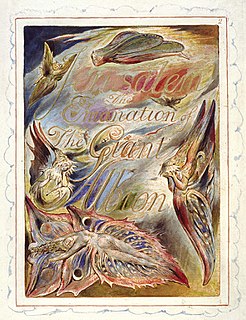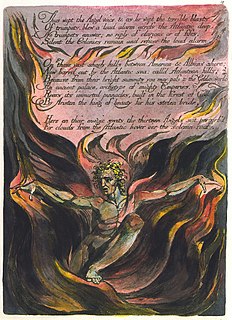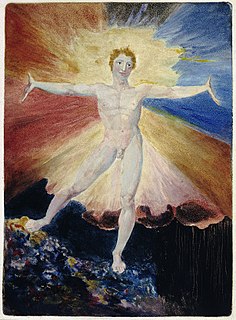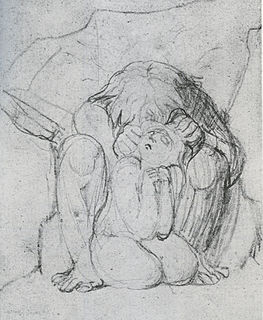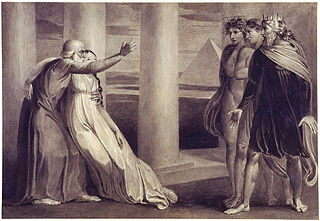Character
Enion is an Emanation, a female essence that is part of one of the divine Four Zoas. She is connected to Tharmas, who is the western and water based Zoas. He is connected to the senses and to the body, and her aspect is sexual desire. It is possible that her name comes from letters used in Enitharmon's name, with Tharmas being the middle portion of the name and hers representing the rest. [1] Tharmas represents a unity within the spirit, and, when Enion is separated from him, she becomes the image of the earth mother. Enion has the power to generate the world. She and Tharmas were able to get along until innocence was taken from their relationship. She wanted to join with Tharmas but could not because of the idea of sin. Along with creating nature, she creates the "Circle of Destiny", which removes Tharmas's aspect of speech by shutting the Gate of the tongue. [2]

Enitharmon is a major female character in William Blake's mythology, playing a main part in some of his prophetic books. She is, but not directly, an aspect of the male Urthona, one of the Four Zoas. She is in fact the Emanation of Los, also male. There is a complex verbal nexus attached. The Zoa Tharmas has emanation Enion, and Eni-tharm(as)-on is one derivation of her name. That should perhaps be read in the inverse direction though, as a construction of the Tharmas/Enion pair's names. Within Blake's myth, she represents female domination and sexual restraints that limit the artistic imagination. She, with Los, gives birth to various children, including Orc.
After her separation from Tharmas, she becomes jealous and attacks other Emanations from his being even though they are her own children. Enion then separates the free aspects, called Jerusalem, from Tharmas's soul and hides from him in what becomes the material world, known as Ulro. She is able to use her power to separate from Tharmas his Spectre, which is a selfish, sexual form of Tharmas. From the union of the two comes Los and Enitharmon, which represents Imagination and Poetry. However, Los and Enitharmon flee. Enion is outraged and believes that the world is cruel. Tharmas allows Enitharmon to hide with him for protection, but Enion soon finds and kills her. [3]
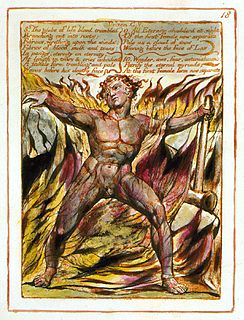
In the mythological writings of William Blake, Los is the fallen form of Urthona, one of the four Zoas. He is referred to as the "eternal prophet" and creates the visionary city of Golgonooza. Los is regularly described as a smith, beating with his hammer on a forge, which is metaphorically connected to the beating of the human heart. The bellows of his forge are the human lungs. Los's emanation, Enitharmon, represents spiritual beauty and embodies pity, but at the same time creates the spatial aspect of the fallen world, weaving bodies for men and creating sexual strife through her insistence upon chastity. In the Book of Urizen (1794), Los and Enitharmon have the child, Orc, who is the embodiment of the spirit of revolution. The name Los is, by common critical acceptance, an anagram of Sol, the Latin word for "sun". Such innovations are common in many of Blake's prophetic poems.
Enion is reduced to wailing and singing. Her song has the power to either create madness or to bring about an apocalypse. The actual song describes lost innocence and the nature of pleasure. [4] Enion can do nothing but wander and be disconnected from Tharmas, even though Tharmas keeps trying to return to her. Albion, the original essence, resigns from power as he was dying because of her wailing, and Urizen, who replaces him, is terrified when he witnesses her. The wailing is used by both Los and Enitharmon to divide Urizen from his Emanation, Ahania. In a human form, Tharmas continues to seek her but he can only hate her. Eventually, they reconcile enough for Tharmas to ask her to come back, but Enion had dissolved into just a wailing voice. During the Final Judgment, Tharmas and Enion are reunited, and the two become like children that are able to enjoy each other sexually. They form an idealistic sexual unity. Eventually, Enion is restored to her form and she joins the rest at Albion's feast. [5]

In the mythology of William Blake, Urizen is the embodiment of conventional reason and law. He is usually depicted as a bearded old man; he sometimes bears architect's tools, to create and constrain the universe; or nets, with which he ensnares people in webs of law and conventional society. Originally, Urizen represented one half of a two-part system, with him representing reason and Los, his opposition, representing imagination. In Blake's reworking of his mythical system, Urizen is one of the four Zoas that result from the division of the primordial man, Albion, and he continues to represent reason. He has an Emanation, or paired female equivalent, Ahania, who stands for Pleasure. In Blake's myth, Urizen is joined by many daughters with three representing aspects of the body. He is also joined by many sons, with four representing the four elements. These sons join in rebellion against their father but are later united in the Last Judgment. In many of Blake's books, Urizen is seen with four books that represent the various laws that he places upon humanity.

